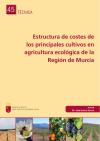Media library
Documentary, graphic and/or audiovisual knowledge objects are offered here, offering information on various sectors and topics. Use the keyword search or search filters to access current audiovisual and documentary knowledge objects useful for your implementation.
If you have any questions or suggestions, please contact us here.

Phytosanitary strategies in tomato
Strategies for the use of phytosanitary products in tomte cultivation

Cost structure of agricultural production areas in the Region of Murcia: stone fruit and citrus fruits
Publication dedicated to the cultivation of regional citrus and stone fruit trees

Cost structure of the agricultural production guidelines of the Region of Murcia: nuts, pome fruit, vines, and olives
Publication dedicated to the most characteristic woody crops of rural Murcia, including nuts, pome fruit, table and wine grapes, and olive trees.

Cost structure of the main crops in organic farming in the Region of Murcia
Document describing the main guidelines for regional organic farming in Murcia

How to assess the quality of your soil. Visual soil assessment in olive groves
Guide that guides allows to estimate the visual evaluation of the soil (EVS) through a quick and simple method to estimate the condition of the soil, the suitability, quality and limitations that a soil presents for the olive grove
Procedure for uprooting olive plantations for ornamental purposes in the Autonomous Community of Aragon
Information on the uprooting of olive tree plantations for ornamental purposes in the Autonomous Community of Aragon
Active ingredients allowed in integrated production for pome fruit trees and restrictions on use
Information on active ingredients in integrated production for pome fruit trees and restrictions on use
Active ingredients allowed in integrated production for stone fruit trees and restrictions on use
Information on active ingredients in integrated production for stone fruit trees and restrictions on use
Rosaceae fire blight
Fire blight is a disease caused by the bacterium Erwinia amylovora that affects various species of the Rosaceae family, including pear, apple, quince, Japanese medlar, etc.
Information note and management recommendations: thrips damage to citrus, persimmon, and pomegranate.
Given the damage caused by thrips observed since May on leaves and fruit in various citrus, persimmon and pomegranate crops and the confirmation of the presence of Scirtothrips aurantii Faure in certain areas, the following recommendations have been considered appropriate:
Recommendations for the strategy to control leaf necrosis in persimmons
During the 2019 campaign, control failures were detected in some plots in the Ribera Alta region (Alzira, Benimuslem, Guadassuar, and Massalavés). Systematic surveys carried out in 2020 revealed that the resistance of the fungus Plurivorosphaerella nawae to the QoI group of fungicides (strobilurins) was present in most persimmon-producing areas in the province of Valencia.
Drosophila suzukii treatment notice for cherry trees
In the various areas where Drosophila suzukii is being monitored, populations of this insect are being detected. Remember that attacks tend to be more intense and frequent at the beginning of the harvest, and treatment will be especially necessary in plots that were attacked in previous years and that left cherries unharvested last year (fly damage or cracking, lack of profitability, etc.).
Notice of treatment of plum moth (Cydia funebrana) in plum trees
The second generation of the plum moth has been seen flying between late May and early June in the Ribera and Val d'Albaida regions, and somewhat later in inland areas. Eggs will hatch this week and next. Treat accordingly.
Olive fly (Bactrocera oleae) treatment notice
The olive fruit fly population is beginning to increase this year, so an initial bait treatment is recommended. Once the first pitted olives appear, the next generation of adults will emerge approximately 25 days later, and a second bait treatment is required to control them.
Monitoring the olive fruit fly (Bactrocera oleae)
Field Pest Situation Report, 2024 Campaign, Week 43: October 21-October 27
Scirtothrips aurantii, information note and management recommendations, damage caused by thrips in citrus, persimmon and pomegranate.
Given the damage caused by thrips observed since May on leaves and fruit in various citrus, persimmon and pomegranate crops and the confirmation of the presence of Scirtothrips aurantii Faure in certain areas, the following recommendations have been considered appropriate:
Phytosanitary bulletin of notices and information
Pollinating insects are vitally important for the proper functioning of crops. Pollination is essential to ensuring the quantity and quality of crops and food production, directly linking wild ecosystems with agricultural production systems.
Plant health, pest reports: Erwinia amylovora (fire blight)
Fire blight is a disease caused by the bacterium Erwinia amylovora that affects various species of the Rosaceae family, including pear, apple, quince, and Japanese medlar trees. It was detected in Cantabria in 2011 and is considered an extremely harmful disease.
“Xylella fastidiosa Conference.” Diseases caused by Xylella fastidiosa and its status worldwide.
On February 12, 2019, a "Seminar on Xylella fastidiosa" was held in the Assembly Hall of the Ministry of Agriculture, Fisheries, and Food. This seminar is part of the measures adopted by the Ministry to disseminate information and raise awareness about the fight against and control of Xylella fastidiosa.




